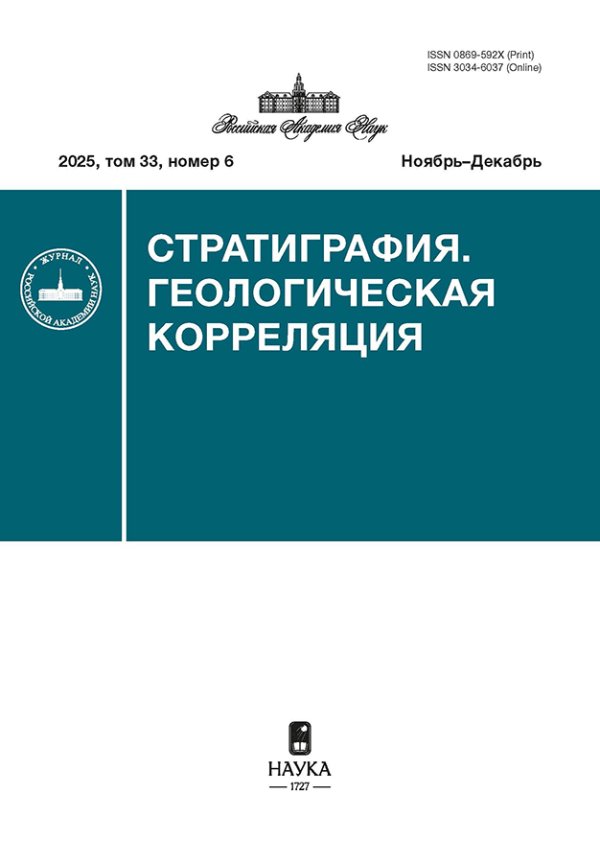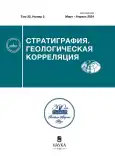Vol 32, No 2 (2024)
Sources of Fine-Grained Aluminosiliciclastics for the Vendian and Early Cambrian Deposits of the Western Part of the East European Platform: Some Lithogeochemical Constraints
Abstract
The article analyzes the lithogeochemical features (content and distribution of the main rock-forming oxides, as well as a number of the trace elements) of clay rocks of the Volyn, Redkino, Kotlin and Lower Cambrian stratigraphic levels of the west part of the East European Platform (Belarus and Volyn, east part of the Baltic monocline, Moscow syneclise). Usage (1) various lithogeochemical approaches and methods; (2) data on the U–Pb isotopic age of detrital zircon populations present in mudstone-associated sandstones; (3) the geochemical features of the supposed source rocks of fine-grained aluminosiliciclastics (magmatic associations of different composition and age in Sarmatia and Fennoscandia) made it possible to express considerations about their possible contribution to the formation of the Vendian and the Early Cambrian clay rocks.
 3-25
3-25


Microfauna, Palynomorphs, and Biostratigraphy of the Upper Bajocian Strenoceras niortense Zone (Middle Jurassic) of the Kuban River Basin, Northern Caucasus
Abstract
The results of the study of microfossils of the Strenoceras niortense Zone of the Upper Bajocian of Karachay-Cherkessian Republic are presented. The zone is represented mainly by dark gray silty-sandy clays, with nodules scattered in the stratum, often forming interbeds, and belongs to the lower part of the upper subformation of the Djangura Formation. The systematic composition and distribution of foraminifera, ostracods, dinoflagellate cysts, and myospores in the section have been established. The volume of biostratigraphic subdivisions for foraminifera, ostracods, and dinocysts has been specified; they were compared with the ammonite scale. According to benthic foraminifers, these are beds with Ophthalmidium caucasicum, comparable with the entire Niortense Zone and most of the Garantiana Zone. The beds with Globuligerina dagestanica established by planktonic foraminifera are compared with the entire studied interval from the Niortense zone to the Lower Bathonian, inclusive. In the middle-upper part of the Niortense Zone (Rostovtsevi and Baculatum Subzones), beds with ostracods Palaeocytheridea (Malzevia) subtilis were established for the first time. Beds with dinocysts Carpathodinium predae, Rhynchodiniopsis? regalis, Meiourogonyaulax valensii are understood within the volume of the Niortense and Garantiana Zones and the lower part of the Parkinsoni zone, inclusive. Images of characteristic taxa of microfauna and dinocysts are given.
 26-47
26-47


Reference Section of the Сampanian Stage of the Southwestern Crimea: Problems of Substage Subdivision and Global Correlation
Abstract
This paper is devoted to new data on the stratigraphy of Campanian deposits in the stratotype of the Kudrinskaya Formation of South-Western Crimea. For the first time, integrated sedimentological, biostratigraphical (ichnofossils, cephalopods, inoceramids, foraminifera, dinocysts, nannoplankton, gilianellids), isotope-geochemical, palaeo- and petromagnetic characteristics of the section were obtained. The boundary of the lower and upper Campanian is determined, confirmed by U–Pb dating of zircons from the well-known keel (bentonite) clay layer in the interval of 77–80 Ma. It is proposed to accept the Campanian substages boundary of the General Stratigraphic Chart of Russia (with a two-fold subdivision) at the top of the C33r Magnetic Chron, located near the δ13C isotopic excursion “MCaE” — Mid-Campanian Event, near the first occurrence of the benthic foraminifer Brotzenella monterelensis and a number of other traditional biomarkers.
 48-103
48-103


Justification of the Age of Sands with Middle and Late Quaternary Theriofaunal Complexes in the Lower Ob’ River Near the Village Khashgort (North-Western Siberia)
Abstract
For more than half a century, the question remained unresolved why the closely spaced sequences of fluvial sands overlying Middle Pleistocene diamicton in the lower reaches of the Ob’ River near the village Khashgort contain micromammal faunas of different evolutionary levels. The sequences 430 and 430a at kilometer 430 from the Ob’ River mouth yielded Late Quaternary faunas and the sequence Khashgort (= Bolshaya Ob’ 440 km) at kilometer 442 from the Ob’ River mouth yielded Middle Quaternary faunas. This contradicted generally accepted ideas, according to which the absence of Middle Quaternary alluvium was assumed in this area and called into question either geological or paleontological interpretations of the Pleistocene history of north of Western Siberia. This paper proposes a comparison between two geological sections using both geological and paleontological methods and suggests an updated biostratrigraphic interpretation of the materials relevant to the Karginian and Tazovian horizons of Western Siberia collected in 1980s and 2016–2022. It is established that the Late Quaternary assemblage of micromammals from the sections at kilometer 430 of the Ob’ River is confined to alluvium of the 2nd terrace above the river floodplain. In the locality Khashgort (Bolshaya Ob’ 440 km) at kilometer 442 of the Ob’ River, the micromammal assemblage is associated with fluvioglacial sands showing the signs of close redeposition of paleontological materials with the outliers comprised in the Middle Quaternary Khashgort aleuropelites bearing boulders and sands. Thus, the study makes it possible to harmonize the geological and paleontological data that were in conflict for more than half a century.
 104-122
104-122


Subfossil Spore-Pollen Spectra of Northern Yakutia as a Key to the Interpretation of Paleoecological Studies
Abstract
The results of the study of spores and pollen from subfossil spectra of samples from the Bykovsky Peninsula (northern Yakutia) are presented in order to compare them with the composition of modern vegetation, to establish the main cryogenic disturbances of palynological remains, and to analyze the mechanisms of their cryogenic destruction. The noticeable content in the spectra of alien pollen of Betula sect. Nanae and Alnus are due to the openness of the studied landscapes, relatively low pollen productivity and the transition to vegetative propagation in harsh climatic conditions of herbs and shrubs, prevailing in the local phytocenoses. The selective role of cryogenesis in the formation of spore-pollen spectra is carried out through repeated cycles of thawing and freezing of sediments, as a result of which physical damages (ruptures and cracks) are formed on palynological remains. The research results are a contribution to the study of the methodological aspects of palynotaphonomy in cryolithozone sediments and can be used for reconstruction of landscapes and vegetation of the Neopleistocene, the study of cryopreservation of remains of living organisms and their diversity in the permafrost areas.
 123-138
123-138












